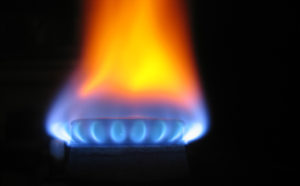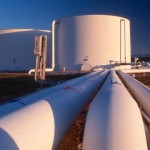 Natural gas was little changed on Thursday ahead of government supply data that are expected to show that US natural gas inventories rose last week, narrowing slightly a deficit to the five-year average. A mild weather outlook kept the market pressured.
Natural gas was little changed on Thursday ahead of government supply data that are expected to show that US natural gas inventories rose last week, narrowing slightly a deficit to the five-year average. A mild weather outlook kept the market pressured.
Natural gas for delivery in May traded at $2.635 per million British thermal units at 8:16 GMT, up 0.61% for the day, having ranged between $2.637 and $2.611 during the day. The contract slid 2.3% on Wednesday to $2.619 and is down ~2.8% for the week so far.
The Energy Information Administration will likely report at 14:30 GMT a stockpile build of 10-12 bcf for the week ended April 3rd as widespread seasonal and slightly warmer conditions dominated during the tracked period. This compares to the five-year average decline for the period of -2 bcf, while stockpiles fell by 8 bcf during the comparable period a year earlier.
If confirmed, this would bring the five-year average inventory deficit to slightly below -180 bcf. A figure above 13-14 bcf would be considered quite bearish, while a gain of less than 5 bcf – bullish.
However, any surprising mismatch to the bullish side will most likely have only a muted effect as short and mid-term weather forecasts continued to see no significant changes, calling for mild weather across most of the US to persist well through the third week of April.
According to NatGasWeather.com, natural gas demand in the US will be low compared to normal through April 15th, with a neutral weather trend for the following seven days.
Higher readings will push into the East today, lifting highs in the 60s and even 70s for Chicago and the Ohio Valley. Severe thunderstorms and showers are expected, particularly across the east-central US, but cooler temperatures will only reach the upper Midwest and far northern New England, leading to some snow accumulations. The remainder of the country will enjoy mostly seasonal temperatures, and even warmer, as no truly cold Canadian air manages to push in the US.
A cooler weather system will pass through the Great Lakes and Northeast on Friday and Saturday, while the intermountain West will occasionally see chilly weather with rain and snow as systems track from the Pacific Ocean.
Active weather will persist across the US during the third week of April but temperatures will remain mild. The southern regions will enjoy near or somewhat warmer-than-usual weather, while the West and Plains are slightly cooler due to Pacific systems with rain and snow. The East will also be mild but there will be an opportunity for a colder weather system to sweep through around April 19-21st. It will need monitoring, although it will have to tap colder Canadian air to induce more significant heating demand.
The following EIA report, due on April 16th, will probably register a slightly larger than average build due to this week’s widespread mild conditions. The five-year average inventory gain for the week ended April 10th is +35 billion cubic feet, while supplies rose by 22 bcf during the same week a year earlier.
The government agency said last Thursday that stockpiles fell by 18 billion cubic feet during the seven days ended March 27th, exceeding analysts’ consensus estimate of -10 bcf. Total gas held in US hubs amounted to 1.461 trillion cubic feet, narrowing a deficit to the five-year average inventories of 1.651 trillion by only 0.1% from a week earlier to 11.5%.
Readings
According to AccuWeather.com, New York will see temperatures peak at 43 degrees Fahrenheit on April 10th, 16 below usual, before establishing in the mid 60s over the following two weeks. Readings in Chicago will max out at 70 degrees today, 14 above normal, and will afterwards be in the upper 50s to mid 60s for most of April.
Down South, highs in Houston on April 10-12th will be seasonal at 78-79 degrees Fahrenheit, and will remain in the upper 70s and low 80s for the rest of the month. Los Angeles will see the mercury peak at 70-74 degrees though April 17th, compared to the average 72-73, before briefly cooling several degrees in the following five days.
Pivot points
According to Binary Tribune’s daily analysis, May natural gas futures’ central pivot point stands at $2.633. In case the contract penetrates the first resistance level at $2.655 per million British thermal units, it will encounter next resistance at $2.691. If breached, upside movement may attempt to advance to $2.713 per mBtu.
If the energy source drops below its S1 level at $2.597 per mBtu, it will next see support at $2.575. In case the second key support zone is breached, the power-station fuel’s downward movement may extend to $2.539 per mBtu.
In weekly terms, the central pivot point is at $2.672. The three key resistance levels are as follows: R1 – $2.760, R2 – $2.808, R3 – $2.896. The three key support levels are: S1 – $2.624, S2 – $2.536, S3 – $2.488.





